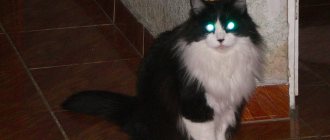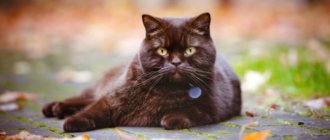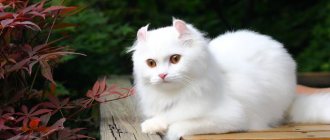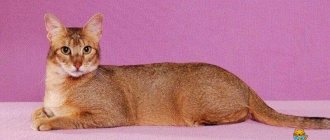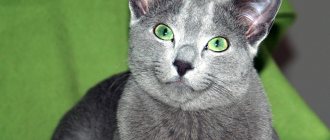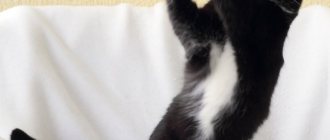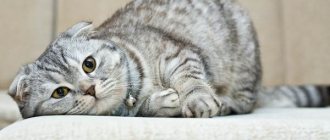Save the article:
The wide possibilities of social networks in June 2015 introduced the world to a snow-white cat named Koby . The phenomenon of the white-furred miracle first occurred on Instagram. The cat's eyes brought worldwide fame - their deep blue color, combined with a black outline, seemed perfect to people. Besides over a million
There were thousands of subscribers subscribed to the fluffy handsome man who unanimously believed that the beauty of Kobe the cat was pure Photoshop.
Let's figure it out in order. Coby is a real living cat born in 2015 in the USA. This is a real March kitten - the celebrity celebrates her birthday in March. As soon as she saw the baby, Rebecca Shefkind felt sympathy for him and took him in her arms. The trusting cat immediately began to sniffle and fell asleep.
The blue-eyed baby got an account at the age of three months thanks to the efforts of the owner, who decided to jokingly introduce people to her pet.
Many people immediately became interested in what breed Kobe is . This is public information: the handsome man is a representative of the British Shorthair cats.
The celebrity shows the best character traits when communicating with his hostess: the favorite of hugs and affection rushes around the apartment with no less pleasure, plays outdoor games and eats canned tuna with a satisfied face. It is not surprising that Kobe chose the master's pillow as his favorite place to sleep.
Photos of a white cat playing in the water with a rubber duck were noticed on social networks. A strange choice of toys for cats, although it is obvious that the animal is delighted with the fun in the water with the duck. Instagram shows a photo of a British Shorthair cat sitting on a sink and in a bathtub.
Despite the suspicion of many about the use of filters that enhance the natural color of the animal's eyes, the cat's appearance is striking - a hypnotizing gaze looks into the very soul.
Who is Kobe
There is a page on Instagram dedicated to this pet, where she supposedly talks about her life and hobbies in the first person.
© shutterstock
Coby belongs to a breed of cat called the British Shorthair with a black-silver chinchilla point color. Usually these animals are distinguished by their gray-blue fur and brown eyes, but sometimes nature makes exceptions. This favorite of millions has become such an unusually beautiful eccentricity.
The description of Coby's cat does not in any way resemble British Shorthairs. She has a snow-white coat and incredibly deep blue eyes. According to Rebecca, the cat’s owner, the account with photographs of her pet was created for fun, and such excessive attention to the animal was quite unexpected. Among her subscribers, the Internet star bears the unofficial title of “The most beautiful cat in the world.”
The character of the cat Koby is no different from other purring pets. She loves :
- soak in the sink or bathtub;
- canned fish, especially tuna;
- swim and play with a rubber ducky;
- sit or sleep in the arms of the mistress.
Gaming potential
The famous cat Kobe with white fur loves to take water treatments with a rubber duck. Animals of this breed are active. Particularly nimble cats have fun by stealing food from the table. These cats need a play area, their own corner. It must have a scratching post.
Animal's play potential
Note! This breed loves toys that they can play with without assistance. A ball, a spring, a tumbler are perfect for this.
There are also more complex play sets with an electronic timer, interactive puzzles and other fun that help increase the intellectual level of your pet.
A ball, a spring, or a tumbler are perfect for this. There are also more complex play sets with an electronic timer, interactive puzzles and other fun that help improve your pet’s intellectual level.
Kobe's image: fact or fiction?
Many social media users believe that Kobe's image is nothing more than a publicity stunt. This guess is due to the fact that the cat’s owner is an illustrator by profession. Skeptics consider photographs to be fiction to attract attention to their creative person.
By posting photos of her pet on the Internet, Rebecca became very popular in her field. But attention is also paid to Kobe. She regularly receives offers to work as a model in advertisements for animal clothing, food, pet stores, etc.
Differences in Temperament
Chihuahuas have an extremely stable psyche, which reaches its development within a year. It is difficult to find cowards and hysterics among them, although of course there are exceptions - as many dogs as there are, so many peculiarities. For the owner, this dog will become a wonderful companion and a faithful, sometimes jealous friend. But some representatives of the breed, depending on the different type of coat, may have different behavioral characteristics. It is believed that dogs with a long coat type have a soft and flexible character and a calmer temperament. Whereas Chihuahuas with short hair are often quick-tempered and live a more active life.
Description of the breed
British shorthair black silver chinchillas according to all standards should not be white. On the contrary, their true color is black. Their notable feature is the charcoal rim of the eyes and nose. The pads on the paws and the tips of the guard hairs are of the same shade.
© shutterstock
According to the breed standard, a cat's eyes must be green. Where does this Internet favorite have such eyes? The fact is that the color of Kobe’s distinctive features is a combination of chinchilla and point colors. The first one has already been discussed above. And the second was previously characteristic only of Siamese cats.
The point color is notable because it is a result of acromelanism. It is characterized by coloring only areas of the skin with low temperatures (paws, tail, ears and muzzle). Jokingly, the appearance of a cat of this color can be described as “white in the middle”, which becomes colored “at the edges”.
This rare British cat, Coby, costs about 35 thousand rubles. Such kittens are born infrequently, but there is still a possibility. So we can easily say that Kobe is not alone.
Health
Bombays have fairly good health and can live up to 20 years. But, unfortunately, the Bombay cat is not native and, like all artificially bred cats, has a number of genetic diseases.
Burmese craniofacial defect
This genetic disease was discovered in the last century. It is caused by a recessive gene that affects the cat's head formation gene and leads to irreversible mutations of the skull and muzzle. It is called Burmese because it is most common among cats of the Burmese breed and their descendants (including Bombays).
The severity of the disease depends on how many copies of the mutated gene there are in the animal's genome. If there is only one copy, the defect is expressed in brachycephaly (short head syndrome). But if there are two copies, then the disease develops into much more serious damage: the syndrome manifests itself in full and causes mutations incompatible with life. Among them are an unformed skull and a bifurcated upper jaw.
Brachycephaly is one of the manifestations of BHD
This genetic disease appeared “thanks” to the efforts of breeders of the Burmese breed. They tried so hard to breed a cat with a perfectly round head that they created a new mutation. In the West it is called BHD. Among the Burmese breed, this disease is an acute problem, especially among American Burmese.
Nowadays, a special DNA test has been developed that detects the presence of a Burmese craniofacial defect in the genome of a cat. BHD only appears if both parents of the offspring are carriers, so the test is very important for breeding work. It is recommended that carrier animals be excluded from breeding, but not all breeders heed this recommendation.
Hypertrophic cardiomyopathy
The disease consists of thickening of the walls of the ventricles of the heart. This makes it more difficult for the muscles to contract, which can lead to a deterioration in your pet's well-being. Diagnosed using ultrasound.
Symptoms of pathology:
- severe shortness of breath;
- tachycardia;
- a significant increase in sleep time;
- bluish color of mucous membranes;
- wheezing, heavy breathing;
- fainting.
The disease can be hidden, without obvious symptoms. Therefore, the animal must be shown to the veterinarian regularly. Fortunately, if detected early, hypertrophic cardiomyopathy can be cured.
Hypertrophic cardiomyopathy is difficult to diagnose, so you need to take your cat to the veterinarian as often as possible so that he can notice the slightest changes
Labored breathing
This disease of Bombay cats has several causes:
- nasal flexure mutations;
- brachycephaly;
- runny nose.
As a rule, in the first two cases it will be impossible to help the cat. But a runny nose usually appears against the background of other problems:
- Fungi, bacteria.
- Viruses.
- Allergy.
- Chronic illnesses.
- Ear inflammation.
- Hypothermia.
- Neoplasms.
- Foreign bodies, irritants.
- Congenital pathologies.
- Parasites.
Treatment is prescribed by the veterinarian according to the cause.
Gingivitis (gum inflammation)
Gingivitis is very dangerous, as it can affect not only the gums, but also the teeth themselves. Causes of gingivitis:
- malocclusion;
- avitaminosis;
- caries;
- tartar;
- the presence of tubular bones in the diet;
- injury to the gums with sharp objects;
- irradiation (during the treatment of oncology using radiation therapy or frequent X-ray examinations);
- infectious processes;
- influence of chemicals;
- viral diseases;
- advanced age of the animal;
- poor nutrition;
- blood diseases (for example, leukemia);
- autoimmune diseases (pemphigus, systemic lupus erythematosus and others).
Gingivitis is very dangerous, because in the later stages the cat can lose teeth
Symptoms of gingivitis:
- lethargy;
- redness on the gums;
- bleeding gums;
- loss of appetite;
- apathy;
- exhaustion;
- bad breath.
Treatment is usually medication. In severe forms of gingivitis, the cat may be operated on and put on a special diet.
Kobe as a cat breed
Because of everyone's attention to the blue-eyed person, swindlers bred their own breed of cats, which they called Kobi and sell the kittens for crazy money.
In fact, Cobby (in the nickname without one “b”) is just the constitution of the animal. It is typical for the following cats :
- British;
- Scottish;
- Persian.
With this type of constitution, pets have a wide sternum, short stature, short limbs and tail. If you follow the information about the characteristics of the breeds, then Coby is most similar to a British or Scottish cat. But for both of these varieties this eye color is completely uncharacteristic. It can be honey, yellowish, brown or soft blue shades, but not blue, like the Internet star's
© shutterstock
People in the know suggest that Kobe is not a purebred British Shorthair. Unfortunately, there is no reliable information about the pedigree of this cat.
But there is an assumption that someone in his family had the albinism gene, which reflected so beautifully on the breed. This theory is confirmed by the tips of the pet’s ears and tail, on which remnants of gray fur are barely visible. When genes are combined, albinism is a dominant trait, so it can easily be passed on from generation to generation.
Usually the albinism gene is accompanied by deafness, but this misfortune bypassed the blue-eyed beauty.
Diet of Japanese Bobtails
Energetic Japanese Bobtails require a balanced diet. It is better to purchase special food for the breed, although it is sold in rare stores. You can order specialized food for bobtails directly on Asian websites.
At least sixty percent of the diet of Japanese bobtails should consist of meat - these animals are exclusively predators, moreover, they have hunting instincts. In the summer, when walking, Japanese bobtails readily eat grass, but for the winter it should be grown in special pots. This will establish the vitamin balance in the cat’s body.
Eighty kilocalories of feed should be per kilogram of weight of an adult animal. Natural food – 30 grams per kilogram of cat’s weight.
Important foods to include in your Japanese Bobtail diet:
- Horse meat, veal, beef - the meat should not be fatty and tough;
- Chicken and turkey;
- Buckwheat, rice, millet, oatmeal - other cereals are not welcome in a cat’s diet;
- Sea fish;
- Low-fat dairy products such as cottage cheese, kefir, sour cream;
- Boiled lungs, liver, kidneys, heart;
- Crushed boiled eggs.
Raw meat must be treated for parasites. To do this, you need to either boil it a little or freeze it for at least 12 hours. After frost, it is poured with boiling water and thawed. The meat should not be warm or cold: it must be at room temperature. Japanese Bobtails will not eat leftover food, so they must be removed immediately. These cats also do not drink dirty water.
At an early age, kittens receive nutrition from their mother. A little later, they should be fed at least six times a day on demand - a growing organism requires a lot of calories. Gradually, meals should be reduced to twice a day.
Maintenance and care
Looking at the photo of a stunning cat, many dream of becoming the owners of the same furry cats. But before contacting nurseries, you need to understand whether you can handle caring for a representative of the breed. Coby, the main character of the article, weighs about 6 kg, and the standard weight of British chinchilla-point cats is from 5 to 8 kg. Sterilized cats and female cats can weigh more than 10 kg.
These are animals with strong immunity, but are predisposed to excess weight, so it is very important to limit their diet and ensure that the pet receives physical activity.
Main genetic diseases:
- Retinal atrophy. In advanced cases, it causes blindness.
- Polycystic kidney disease. This is indicated by the animal's apathy, thirst, weight loss, and vomiting. A sick cat often goes to the litter box and stops playing.
- Hypertrophied cardiomyopathy. It can be fatal, so it is important to contact your veterinarian promptly.
Another point related to grooming is the need to thoroughly comb your pet’s coat. The British have a dense, thick undercoat, so they carry out grooming at least 2 times a week.
Other recommendations:
- Wash your pet no more than 2 times a year; the rest of the time, use dry shampoo to keep its fur clean.
- Clean your ears every week with cotton swabs and a special lotion.
- Clean your eyes regularly.
The diet should be dominated by premium food, and water should be freely available in a special bowl. A natural food system is acceptable, the basis of which is beef, boiled chicken and rabbit, fresh vegetables and herbs, lean fish (boneless and skinless fillets), eggs. Interestingly, Kobe loves canned tuna, but it is not yet known whether other representatives of the breed will also love them.
Snow-shoe (snow slipper)
The breed appeared as a result of crossing a Siamese cat and a spotted shorthaired American beauty. By 1980, the breed had its own standard. Characteristic features of the animals are white paws, a white spot on the chest and a stripe of the same color on the muzzle. The pet is very gentle, charming, affectionate, affectionate, and never shows excitement or nervousness. Snowshu accompanies its owners everywhere, with whom they don’t mind playing. Kind and tolerant of children. The price per animal is from 500 to 800 dollars.
The Burmilla was bred in 1981 in the UK as a result of an accidental crossing of a Persian chinchilla and a Burmese, which led to the appearance of charming kittens with a shaded silver color. This breed was recognized by the GCCF in 1989, and by the FIFe in 1994. The pet has a balanced character, does not show aggression in the company of other cats, and loves to play with all kinds of objects. Requires constant brushing of the coat. The cost of the animal varies from 800 to 4 thousand dollars.
The breed is classified as semi-longhaired and was developed in the late 1960s in the USA. As can be concluded from the name of the breed “rag doll”, the animal is soft, affectionate and very pliable. Owners of pets of this breed claim that they are able to replace children in the family. They are distinguished by their intelligence and playfulness. Very affectionate, can easily get along with other pets. In case of danger, they hide because they are unable to defend themselves. The price of an animal can reach 2 thousand dollars.
As the name suggests, the breed was developed in Russia. In 1992 the breed was recognized by FIFe. The character of the “Siberian” is independent, they make excellent hunters. At home, this is an affectionate, imposing creature that is able to relieve any stress from its owner. They are very active, playful, affectionate, hardy and unpretentious. They are just toilet trained. However, sometimes they show restlessness and willfulness. They don't always respond to attention with affection. The cost of a pet is 500-600 dollars.
The eyes of cats are so expressive that you can look into them without stopping, like looking at fire, water or the starry sky. However, you can simply drown in the eyes of this cat! I don’t know about you, but I’ve never seen a cat with such beautiful blue eyes.
Tolerance for children
The “chinchilla British” treat children leniently. They tolerate them rather than love them. This is understandable, because children vigorously express delight at the “fluffy miracle” and begin to squeeze it or pull its tail. In the latter case, a cat like Kobe will show all his restraint. He will not scratch them, hiss threateningly, or take an aggressive posture. But the “British” will not put up with inappropriate treatment of himself. The animal will only imposingly retire to a secluded place, demonstrating its intelligence and upbringing. If you take a “fluffy” into the family as a kitten, he will more easily adapt to the children in the house. A naturally friendly animal will have fun frolicking with them. In other cases, cats like Kobe perceive them as human cubs. They are ready to protect them and are able to understand annoying pestering, but they treat children without much interest.
Classification by size
The fashion for dividing breeds into categories based on the overall size of the dog came from foreign countries. In particular from America, where the term “tea cup” has long been established
).
In Russia, the following terms are used for classification:
- standard;
- mini;
- super mini.
The classification is carried out not so much by size as by body weight. In the first case, an adult dog corresponds to the weight recommended by cynological federations, i.e. weighs between 1.5 and 3 kg.
The last two miniature types of the Chihuahua breed do not have generally accepted boundaries, so each breeder interprets them to the best of his interests and knowledge. However, stick to the following weights:
- mini: from 1000 to 1500 grams;
- super-mini: from 500 to 1000 grams.
The FCI allows the weight of an adult Chihuahua dog to range between 500 and 1500 grams, but, as a rule, you should not expect high marks from judges at a breed show. In some cases, disqualification will follow, this also applies to the dir type.
To preliminarily determine the puppy's future weight as an adult, a special Chihuahua weight table has been developed. Of course, neither the table nor the seller guarantees the stated indicators.
Why you should not buy mini and super-mini Chihuahuas is described in detail in this article. Read on to avoid common mistakes made by novice breeders and hobbyists.
How much will a lynx cost?
The price varies from 40 to 60 thousand rubles and depends on a lot. First of all, it depends on age and habituation to hands and the toilet, on the method of breeding and on the attitude of those who breed them.
Interesting materials:
What is dance good for? What is a meat grinder used for? What is the purpose of the toolbar in the graphic editor? What is the purpose of the turbine? What is the purpose of the fryer? Why was the horoscope invented? Why was the hourglass invented? What is Darnitsa nicotinic acid used for? What is Heptral used for? What are color indicators used for?


